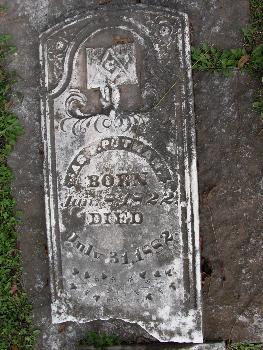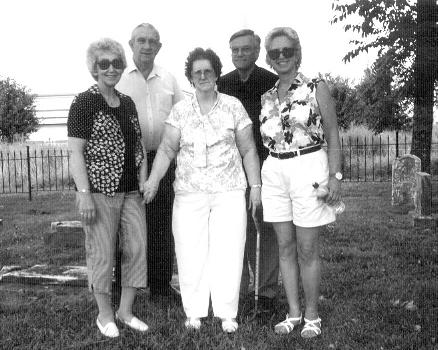James Pervine Putman (Jan 08, 1822 - Jul 31, 1882)
Marinda Patterson Putman (Jun 02, 1827 - Nov 27, 1863)
James Pervine Putman was the son of Jahu and Rachel Bond Putman. James and his wife Marinda had six children. The Putman family cemetery was originally located on James Pervine Putman's property.
- On Nov 19, 1874, John Putman married Alice C. Ferguson (born ca. 1863)
She is known as "Annie" in the 1880 census. She is the daughter of Charlotte Ferguson.
John was a baker and moves to Capron, Washington County, Oklahoma by 1910.
- Todd married Celise (1880 - )

James Pervine Putman tombstone in the Putman cemetary between Rogers and Bentonville, Arkansas
INTERVIEW WITH GRACE COLE Feb. 2, 1998
By Marie Putman Grace's grandmother, Elvira Sophroni "Frone" (James Pervine's daughter and Jahu's granddaughter), was born July 2, 1856. She talked of living in a large house down the hill from the Putman cemetery. Her mother, Marinda Patterson, died when Elvira was real small -- only seven years old. After the death of James' first wife he married Mary Newcomb January 8, 1865, so he would have someone to take care of the children while he was in session in Little Rock.* Elvira walked to the nearby Droke schoolhouse to attend school. Elvira often told how her step-mother was so mean and lazy that she wouldn't wash the dishes. Elvira would have to run home at noon and eat her dinner and wash the dishes and run back to school. One day the wicked step-mother broke Elvira's nose while her father was gone to legislature. It swelled and was so awful looking, she hid under the bed to keep her dad from seeing it. But "aunt Mary," as the kids called their step-mom, told her husband. She said, "Now you may want me to pack up my things and leave, but I broke Frone's nose." Her brother Bill had diarrhea when he was little and his step-mother would whip him so hard for having dirty pants that the little thing would go down to the spring and take his pants off and wash them to keep from getting beaten. Through the war, during the battle of Pea Ridge, Elvira's daddy would have to hide their meat up in the chimney in the fireplace so the soldiers wouldn't take it. Elvira told of someone dying during the war, and that could have been when the cemetery started. They couldn't bury them in a regular cemetery so they went "aways" from the house, "up the hill," and buried them. "That could have been the first person buried there," Grace said.
|
Alma married and moved to California. She separated from her husband when Grace was only two years old and came back to live with her mother on a farm at Mason Valley. Grace walked a half mile to school and a half mile home each day. She remembers her grandma Elvira always wore an apron. And she dipped Garret snuff. She would make her toothbrush that she would dip her snuff with from a certain kind of a tree or bush that they would gather while walking an old wagon trail to town to get a few groceries.
"Grandma would smoke our meat in an old trailer. I'd help her make the bags that she'd put the sausage in. We'd can sausage and meat. I've helped render lard and make lye soap. A neighbor would butcher for us and Mom would help his wife render lard. My mother married one of our neighbors who would help butcher, and he only lived two years and three months after the marriage. He died in October just before my grandma died in December. I had a 4-H pig. Mom and dad Mason bought all of its feed and I got credit for him in school. When it was time to butcher him my folks gave me about $5 for the pig. I could hardly stand to eat that meat, knowing that came from the pig. I had him so spoiled. "We also had chickens and we had one cow that had twin calves and we named them Bessie and Elinor, after two president's wives." Grace remembers her great Uncle John. He lived in Copan, Ok. When Grace was real sick they went to visit him. His wife Alice was real bad sick. After she died they moved Grace's great Uncle Bill and his wife Stella in with them and took care of them. Stella had palagua, a disease where the skin came off her hands and arms and how white they were. She died at their house and later her husband Bill also died there. Grace said, "I learned to piece quilts as Mom and Grandma quilted. In the summer time I'd lay underneath the quilts and play with my dolls. The women would stick needles down through the quilts and I would thread them and stick them back up through and they would pull them through and use them. When night would come they would roll the quilts up to the ceiling and we could walk under them. They didn't have frames like I have to work quilts on." Grace was in the tenth grade when her grandmother died. She and Alma remained on the farm until after Grace graduated. That house was only recently torn down to make way for the new airport. Alma later moved into Bentonville. Grace, Alma's only child, married and had two sons. When she became a widow she moved in with her mother. Grace continues to live there since her mother's death and still quilts the most exquisite quilts, giving away many of them. *The Historical Report Of The Secretary Of State, Sesquicentennial Edition, 1986 (p.338) lists J.P. Putnam (should be Putman) as serving in the Thirteenth General Assembly of Arkansas House of Representative 1860-1862. During that time there was only one regular session - November 5, 1860 to January 21, 1861 and two special sessions, November 4-18, 1861, and March 5-22, 1862. The book also lists (page 350) the same James Putnam (misspelled) of Benton Country served on the Twentieth General Assembly of the House from November 10, 1874 to March 5, 1875 and November 1 to December 10, 1875. According to Cora Scoggins, "James Pervine Putman was born in Tennessee. Miranda died at the beginning of the Civil War, leaving him with six children, ages 1 ½ - 14 years. James Putman was sent to the state legislature twice; once he didn't ask to be sent (was probably appointed). He contacted typhoid fever during his last term and never recovered. He was a Mason, and was buried on his land by the Masons. His father and mother died at his home and were also buried in the family burying place (Putman Cemetery), along with his sister, Sarah Dwyer and daughter Josephine DeHart. He gave each of his children 40 acres of land, or the value of it, and some money besides. After his death, the land was sold, signed by each child and son-in- law or daughter-in-law. The Cemetery was not sold, was retained by Putman's. According to the afore mentioned book,"Arkansas was a slave state, the principal slave holdings being in the river bottom country where cotton thrived. Slaves were not so important in the hill country of the north and west. When talk of abolition came the state was sharply divided." (page 15) "When the Civil War began, April 12, 1861, Governor Henry M. Rector refused to provide troops for the Union side. The Governor instead sent a force to take the Fort Smith Arsenal. He had already captured the LR Arsenal in February of that year. On May 6, 1861, at LR, a Secession Convention adopted an Ordinance of Secession by a final vote of 69 to 1."(It is probable that James Putman was at this Secession convention and cast a vote for this ordinance). "The dissenting vote was cast by Isaaac Murphy, who later became the first Union Governor in 1864. "On May 20, 1861, Arkansas became one of the Confederate States of America. A war loan of $2,000,000 was appropriated and a preliminary call for 30,000 men was issued. The first military engagement of importance on Arkansas soil was the Battle of Pea Ridge, or Elk Horn Tavern, in Benton County, March 6, 1862. The three-day battle was the largest and most important Civil War battle west of the Mississippi River. The field was left in possession of the Federal troops." (Page 16) Arkansas seceded from the Union May 8, 1861; readmitted to the Union June 22, 1868.
Grace Cole (in middle), with cousins, Huroa Williams, Jerry Putman
(distant cousin) James Webb, Juanita Rigali at Putman Cemetery in Bentonville, Arkansas.
